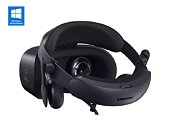Mixed reality headsets seem to present a new opportunity for the Virtual Reality segment, and Samsung has taken advantage of this trend by announcing the new Samsung HMD Odyssey+, a product that stands out for a novelty in its OLED displays that eliminates the screen door effect. This is a visual artifact of displays where the fine lines separating pixels become visible on the screen. This effect hurts the visual experience, but it can also cause dizziness or nausea.
Samsung say they have solved the problem with an innovation called "Anti-Screen Door Effect (Anti-SDE) Display". This technology helps to increased the perceived resolution of the displays, and according to Samsung the user will have a perceived screen density of 1,233 PPI. The actual density is 616 PPI on a conventional AMOLED, but with the new Anti-SDE AMOLED technology that resolution promises to double virtually before our eyes.




In addition, the new Samsung HMD Odyssey+ offers support for 360° spatial sound that simulates 3D audio on the built-in headphones. The weight is 590 g and the design of the glasses is a slight variation of last year's model that offers a little more space in the protection of the eyes (146 vs 138 mm) and the nose (40 vs 32 mm). This headset includes two pre-paired controllers, 110° Field of View and 6 Degrees of Freedom (6DOF) tracking.
The new Samsung HMD Odyssey+ is available today in the United States at the same price as last year's model: $499.99. It's a pity, but at the moment this headset does not make use of that new VirtualLink connection that NVIDIA has tried to promote in its new GeForce RTX 2000 graphics family. We'll have to wait for real, independent reviews to confirm if we can say goodbye to that annoying Screen Door Effect, though.
View at TechPowerUp Main Site
Samsung say they have solved the problem with an innovation called "Anti-Screen Door Effect (Anti-SDE) Display". This technology helps to increased the perceived resolution of the displays, and according to Samsung the user will have a perceived screen density of 1,233 PPI. The actual density is 616 PPI on a conventional AMOLED, but with the new Anti-SDE AMOLED technology that resolution promises to double virtually before our eyes.




In addition, the new Samsung HMD Odyssey+ offers support for 360° spatial sound that simulates 3D audio on the built-in headphones. The weight is 590 g and the design of the glasses is a slight variation of last year's model that offers a little more space in the protection of the eyes (146 vs 138 mm) and the nose (40 vs 32 mm). This headset includes two pre-paired controllers, 110° Field of View and 6 Degrees of Freedom (6DOF) tracking.
The new Samsung HMD Odyssey+ is available today in the United States at the same price as last year's model: $499.99. It's a pity, but at the moment this headset does not make use of that new VirtualLink connection that NVIDIA has tried to promote in its new GeForce RTX 2000 graphics family. We'll have to wait for real, independent reviews to confirm if we can say goodbye to that annoying Screen Door Effect, though.
View at TechPowerUp Main Site




